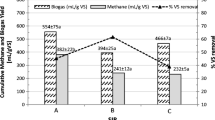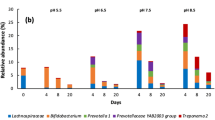Abstract
The effect of manure concentration on the growth of the heterogeneous microbial population under batch condition was studied. Four manure concentrations were used in the study. The dehydrogenase activity was used as a measure of the active biomass in the manure. The chemical oxygen demand test was used to measure the change in organic material caused by biological activities. The growth curve of the heterogeneous microbial population in swine manure was essentially similar to that of a pure culture grown batchwise in that it had the four principle phases: lag, exponential growth, stationary, and death. The exponential growth phase followed a diauxic growth pattern. High concentration of manure had an inhibitory effect on the microbial growth. Manure diluted less than 1:3 (manure:water) depressed the specific growth rate of the microbial population.
Similar content being viewed by others
References
Ghaly, A. E. (1982), Ph.D. thesis, Department of Agricultural Engineering, McGill University, Montreal, Quebec.
Loehr, R. C. (1974),Agricultural Waste Management: Problems, Processes and Approaches. Academic Press, New York.
Stainer, R. J., Adelberg, E. A., Ingraham, J. L., and Wheelis, M. L. (1979),Introduction to Microbial World. Prentice-Hall, New Jersey.
Robinson, K. and Loehr, R. C. (1974),Crit. Rev. Environ. Cont. 4(2), 193–217.
Coackley, P. and O'Neill, J. (1975),J. Water Poll. Contr. 74(4), 404–414.
Hawker, L. E. and Linton, A. H. (1971),Microorganisms' Function, Form and Environment. Edward Arnold, London.
Lewin, G. V., Glendenning, J. R., Helm, A. M., and Rouk, E. (1964),Bioscience 4 (1), 37–46.
Lenhard, G., Ross, W. R., and DuPloor, A. (1964), Proceedings of the 2nd International Conference on Advances in Water Pollution Research, Tokyo, Japan.
Bucksteeg, W. (1966), Proceedings of the 3rd International Conference on Advances in Water Pollution Research, Munich, Germany.
Ghosh, S. G., Pohland, F. G., and Gates, W. E. (1972),Water Poll. Contr. Fed. 44(3), 376–400.
Ghosh, S. G. (1969), Ph.D. thesis, Georgia Institute of Technology, Atlanta, GA, 230 pp.
APHA (1985), American Public Health Association, New York.
Gaudy, A. E., Gaudy, E. T., and Komolrit, K. (1963),J. Appl. Microb. 5(1), 157–162.
Bhalta, M. N. and Gaudy, A. F. (1965),J. Appl Microb. 12(2), 345–352.
Porges, N. L., Jasewicz, L., and Hoover, S. K. (1953).J. Appl. Microb. 1(2), 202–208.
Stevens, R. J. and Cornforth, I. S. (1974),J. Sci. Food Agric. 25(5), 1249–1261.
Phillips, P. A. (1972), Unpublished M.Sc, McGill University, Montreal, Quebec.
Author information
Authors and Affiliations
Rights and permissions
About this article
Cite this article
Ghaly, A.E., Kok, R. & Ingrahm, J.M. Growth rate determination of heterogeneous microbial population in swine manure. Appl Biochem Biotechnol 22, 59–78 (1989). https://doi.org/10.1007/BF02922697
Issue Date:
DOI: https://doi.org/10.1007/BF02922697




